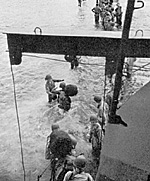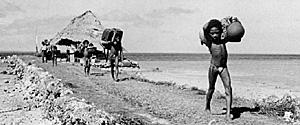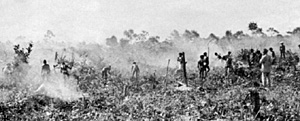 The Landings
The Landings
About half the Woodlark Force-units of the 112th Cavalry, the 134th Field Artillery Battalion, and the 12th Marine Defense Battalion-left Townsville on 25 June aboard six LST's, with one subchaser and two destroyers as escort.
TROOPS DISEMBARKING FROM LCI at Kiriwina Island wade ashore, 30 June 1943.
The voyage to the target was uneventful. Landing of the 2,600 troops began at 2100 of 30 June. Unloading of the LST's at their beaching points was rapid. Cunningham's force had borrowed extra trucks at Townsville to permit every item of equipment to be put aboard a truck which was driven aboard an LST at Townsville, then driven off at Woodlark. Emptied of their loads, the slow-moving LST's cleared Woodlark before daylight.
Two APD's, carrying part of the Woodlark Force from Milne Bay, arrived shortly before 0100, 1 July, but encountered trouble in navigating the channel with the result that landing craft were not put into the water until 0230. The landing craft coxswains had trouble finding the right beach, but by 0600 the APD's were emptied and ready to leave. Some confusion had existed on the beach, but not enough to prevent its being cleared by the same time.
Additional echelons arrived in LCI's and LST's on 1 July, and all these were unloaded quickly and easily. The LST's took 310 instead of the 317 trucks, Cunningham explained, because one LST raised its bow ramp and closed its doors before all its trucks could be driven aboard.
On shore, defense positions were set up. Antiaircraft and coast artillery pieces of the 12th Defense Battalion were installed, and machine gun and 37-mm beach positions were established.
 NATIVES CARRYING LUGGAGE which had been deposited on the coral causeway,
north shore of Kiriwina Island, 1 July 1943.
NATIVES CARRYING LUGGAGE which had been deposited on the coral causeway,
north shore of Kiriwina Island, 1 July 1943.
Cargo was moved inland, and work on the airfield began on 2 July.
Meanwhile Colonel Herndon's Kiriwina Force had been landing, but without the smoothness that characterized operations at Woodlark. Shortly after dawn on 30 June, twelve LCI's, which with six escorting destroyers had sailed from Milne Bay the previous noon, began landing their 2,250 troops. Trouble accompanied the landing from the start. The LCI's had great difficulty getting through the narrow, reef-filled channel to Red Beach near Losuia. And the water shallowed near shore so much that they grounded 200-300 yards from the shoreline. The landing went slowly. ( Colonel Herndon stated on 16 November 1953 that part of the trouble arose from a navigational error that caused the ships to sail past Kiriwina and made them late. He also stated that, originally, the main body was to land on the north coast, but that. for some reason the plan was changed and Red Beach and Losuia jetty were used.)
Sunset of 30 June saw the arrival of twelve LCT's and seven LCM's which had left Milne Bay on 29 June and stopped overnight at Goodenough Island. Again there were problems. Heavy rains were falling. The tide was out. Only one LCT was able to cross a sandbar which blocked the approach to the jetty at Losuia. Other LCT's hung up on the bar and were forced to wait for the tide to float them off. The remainder made for Red Beach but grounded offshore with the result that much of the gear on board had to be hand-carried ashore. Some of the vehicles were driven ashore, but several drowned out in the salt water.
LCT's in subsequent echelons avoided some of the difficulties by landing on the north shore of Kiriwina where the coral causeway had been built. Here trucks could back right up onto the bow ramps of the LCT's, but several were damaged by sliding off the causeway.
In the absence of enemy interference Admiral Barbey approved a change in the original plan to move part of the supplies to Goodenough aboard LST's, then transship them to LCT's for the trip to Kiriwina.
 JEEP AND TRAILER LEAVING AN LST anchored off north shore of Kiriwina Island,
July 1943
JEEP AND TRAILER LEAVING AN LST anchored off north shore of Kiriwina Island,
July 1943
After 12 July LST's sailed directly from Milne Bay to the north shore of Kiriwina.
Unloading on the north shore, while easier than at Losula, complicated matters further for the troops ashore. Heavy equipment was landed some distance from the proposed airfield near Losuia. Building the necessary roads was slowed by heavy rains and lack of enough heavy engineer equipment.
Base Development
Meanwhile the construction program at Woodlark went forward. By 14 July the airfield was near enough completion to accommodate C- 47's. One week later 5,200 feet of runway were surfaced with coral, and on 23 July the air garrison, the 67th Fighter Squadron which had served on Guadalcanal in the grim days of 1942, arrived for duty.
On Kiriwina heavy rains continued and added to the engineers' troubles in building and maintaining roads. All construction equipment was used on the roads until about 10 July; during that time the airfield site was partly cleared with hand tools. General Krueger visited the island on 11 July and expressed his dissatisfaction with the progress of road and airfield construction. Three days later he placed Col. John T. Murray, formerly of the 41st Division, in command of the Kiriwina Task Force and returned Colonel Herndon to command of the 158th Infantry. Herndon had asked for more engineers and machinery. These arrived after Murray took command and thereafter the work went faster. By D plus 20 the first airstrip, 1,500 feet long, was cleared, roughly graded, and ready for surfacing. By the month's end the strip was 5,000 feet long and ready for coral. No. 79 Squadron of the RAAF flew in and began operations on 18 August.
 CLEARING AIRFIELD SITE WITH HAND TOOLS, Kiriwina Island, July 1943.
CLEARING AIRFIELD SITE WITH HAND TOOLS, Kiriwina Island, July 1943.
Except for reconnaissance and two small bombing attacks against Woodlark, the enemy did not react to the invasions, so that Barbey was able to transport twenty echelons to Kiriwina and seven to Woodlark without losing a ship or a man. By mid-August transport of supplies and men to the two islands was no longer a tactical mission. U.S. Army Services of Supply was ready to relieve Barbey of logistical responsibility.
Thus the Southwest Pacific Area, using small forces, was able to secure two more airfields to further the Allies' control over the Solomon Sea.
More Cartwheel Begins: The Southwest Pacific
- Introduction
Operation Chronicle; Woodlark-Kiriwina
The Landings: June 30, 1943
Invasion of Nassau Bay
Landing of the MacKechnie Force
Back to Table of Contents -- Operation Cartwheel
Back to World War Two: US Army List of Issues
Back to MagWeb Magazine List
© Copyright 2002 by Coalition Web, Inc.
This article appears in MagWeb (Magazine Web) on the Internet World Wide Web.
Other military history articles and gaming articles are available at http://www.magweb.com